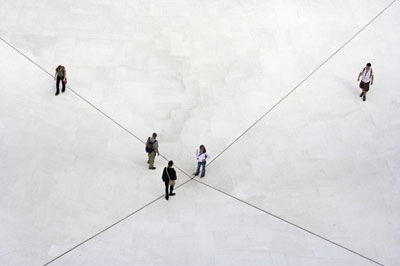 |
||||
|
||||
|
||||
ARTEXT : La Biennale di Venezia
TOPOLOGICAL GARDENS
Topological Gardens, as its systematic confusion between outside and inside, and private and public suitably interplays and dialogues with Nauman’s works. It is there, in between works and buildings, where the viewer’s imagination allows her to piece together her experiences, reinventing the work while traversing the city. Like Leibnitzian monads, each of the three sites could be seen independently, in any combination, and thus there is no preferred order in which to go from one to the other. What does count is the space between them, as well as the experience of finding them. If the three sites in which the exhibition takes place are called upon to stand as visible manifestations of the topological urban structure of the city, then the three conceptual threads that drive the show allow the viewer to imagine a topological logic behind Nauman’s work. Each of these threads is organized like a sentence, in which the individual works are words or clusters of notes in a musical script. The threads—Fountains and Neons, Heads and Hands, and Sound and Space—are inconclusive, as they do not intend to exhaust the possibilities of Nauman’s specific artistic operation, but rather indicate its directionality. Their mode of operation is simple:each thread is just a connector, existing between two terms that are tentative examples of possible polarities—open categories that do not pretend or intend to constrain the constantly surprising open-endedness in which Nauman’s work operates. Neither is it precluded that the elements in one thread could become part of another. The relationship between the elements of the threads is topological—it always seems possible to imagine the passage from one to the other by stretching and twisting, shrinking and contracting, to quote words used by Nauman. Influenced early on by philosophy and literature including Wittgenstein’s Philosophical Investigations and Samuel Beckett’s Molloy—Nauman constantly tests rational systems of language, spatial and bodily boundaries, duration, and psychology, using sculpture, video installations, and constructed environments. In the late 1960s, Nauman continued to work with neon and also began to construct corridors, sometimes filming his performances within them. Larger constructed environments in the early 1970s often included video surveillance cameras and monitors that overlook and record viewers as they entered these spaces. Nauman continued to make large sculptures and installations in the 1970s and early 1980s, mapping space with masking tape or evoking physical or psychological constraints through the creation of passages and tunnels. Nauman halted his work with video for about a decade before taking it up again in the mid 1980s with many multi-channel video installations that further explored language and his metaphorical use of labyrinths and the personae of rats and clowns. In the late 1980s, he also introduced the iconography of life-sized animals cast in wax that hang suspended in carousel-like formations. The 1990s brought sculptures of human heads and hands in wax and bronze, video installations, and sustained work.
Curator : Carlos Basualdo Artisti : Bruce Nauman
Web site: http://www.naumaninvenice.org |
||||
Artext © 2009 |
